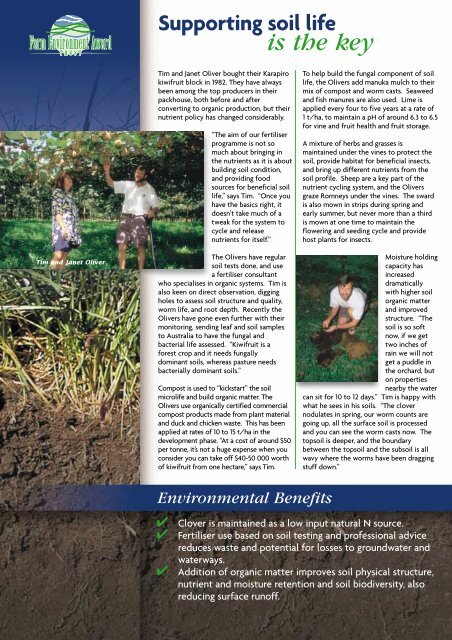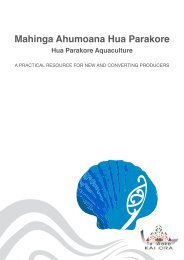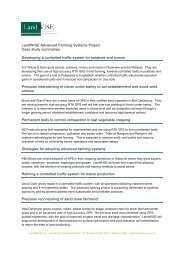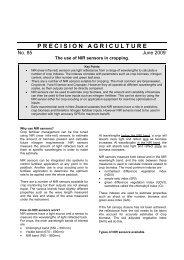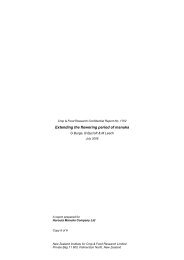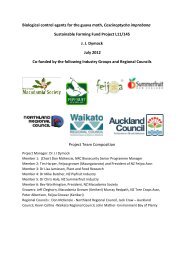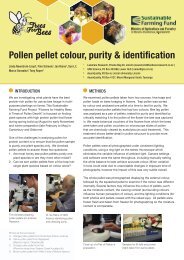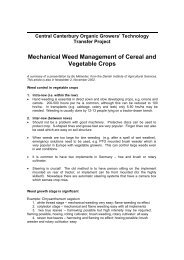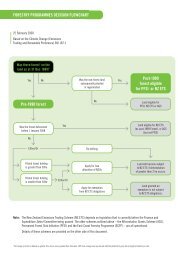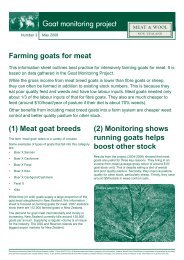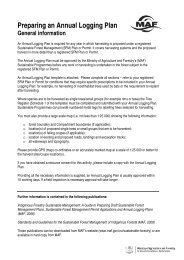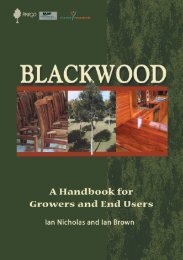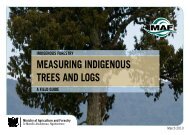Getting Smart with Nutrients
Getting Smart with Nutrients
Getting Smart with Nutrients
Create successful ePaper yourself
Turn your PDF publications into a flip-book with our unique Google optimized e-Paper software.
Supporting soil life<br />
is the key<br />
Tim and Janet Oliver<br />
Tim and Janet Oliver bought their Karapiro<br />
kiwifruit block in 1982. They have always<br />
been among the top producers in their<br />
packhouse, both before and after<br />
converting to organic production, but their<br />
nutrient policy has changed considerably.<br />
“The aim of our fertiliser<br />
programme is not so<br />
much about bringing in<br />
the nutrients as it is about<br />
building soil condition,<br />
and providing food<br />
sources for beneficial soil<br />
life,” says Tim. “Once you<br />
have the basics right, it<br />
doesn’t take much of a<br />
tweak for the system to<br />
cycle and release<br />
nutrients for itself.”<br />
The Olivers have regular<br />
soil tests done, and use<br />
a fertiliser consultant<br />
who specialises in organic systems. Tim is<br />
also keen on direct observation, digging<br />
holes to assess soil structure and quality,<br />
worm life, and root depth. Recently the<br />
Olivers have gone even further <strong>with</strong> their<br />
monitoring, sending leaf and soil samples<br />
to Australia to have the fungal and<br />
bacterial life assessed. “Kiwifruit is a<br />
forest crop and it needs fungally<br />
dominant soils, whereas pasture needs<br />
bacterially dominant soils.”<br />
Compost is used to “kickstart” the soil<br />
microlife and build organic matter. The<br />
Olivers use organically certified commercial<br />
compost products made from plant material<br />
and duck and chicken waste. This has been<br />
applied at rates of 10 to 15 t/ha in the<br />
development phase. “At a cost of around $50<br />
per tonne, it’s not a huge expense when you<br />
consider you can take off $40-50 000 worth<br />
of kiwifruit from one hectare,” says Tim.<br />
To help build the fungal component of soil<br />
life, the Olivers add manuka mulch to their<br />
mix of compost and worm casts. Seaweed<br />
and fish manures are also used. Lime is<br />
applied every four to five years at a rate of<br />
1 t/ha, to maintain a pH of around 6.3 to 6.5<br />
for vine and fruit health and fruit storage.<br />
A mixture of herbs and grasses is<br />
maintained under the vines to protect the<br />
soil, provide habitat for beneficial insects,<br />
and bring up different nutrients from the<br />
soil profile. Sheep are a key part of the<br />
nutrient cycling system, and the Olivers<br />
graze Romneys under the vines. The sward<br />
is also mown in strips during spring and<br />
early summer, but never more than a third<br />
is mown at one time to maintain the<br />
flowering and seeding cycle and provide<br />
host plants for insects.<br />
Moisture holding<br />
capacity has<br />
increased<br />
dramatically<br />
<strong>with</strong> higher soil<br />
organic matter<br />
and improved<br />
structure. “The<br />
soil is so soft<br />
now, if we get<br />
two inches of<br />
rain we will not<br />
get a puddle in<br />
the orchard, but<br />
on properties<br />
nearby the water<br />
can sit for 10 to 12 days.” Tim is happy <strong>with</strong><br />
what he sees in his soils. “The clover<br />
nodulates in spring, our worm counts are<br />
going up, all the surface soil is processed<br />
and you can see the worm casts now. The<br />
topsoil is deeper, and the boundary<br />
between the topsoil and the subsoil is all<br />
wavy where the worms have been dragging<br />
stuff down.”<br />
Environmental Benefits<br />
✔ Clover is maintained as a low input natural N source.<br />
✔ Fertiliser use based on soil testing and professional advice<br />
reduces waste and potential for losses to groundwater and<br />
waterways.<br />
✔ Addition of organic matter improves soil physical structure,<br />
nutrient and moisture retention and soil biodiversity, also<br />
reducing surface runoff.


